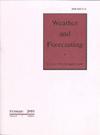结合数值天气预报和地面观测数据的时空卷积法短期预报每小时暴雨概率
IF 3
3区 地球科学
Q2 METEOROLOGY & ATMOSPHERIC SCIENCES
引用次数: 0
摘要
对于数值天气预报(NWP)模型来说,准确预测短期降雨量,特别是预测每小时暴雨(HHR)概率,仍然是一项挑战。在此,我们介绍一种深度学习(DL)模型 PredRNNv2-AWS,它是一种卷积递归神经网络,专为确定性短期降雨预报而设计。该模型集成了地表降雨观测数据和精密天气分析和预报系统(PWAFS)模拟的大气变量。我们的 DL 模型可生成未来 13 小时的每小时降雨预报。定量评估显示,在 5 毫米/小时的临界值下,使用地表降雨观测数据作为预测因子之一可获得更高的性能(威胁评分),在前 3 小时和整个预测小时内,相对于 NWP 模拟分别提高 263% 和 186%。注意到光流方法在最初几个小时也表现良好,但与其他实验相比,其预测结果在最后几个小时迅速恶化。然后,整合机器学习模型 LightGBM,根据 PredRNNv2-AWS 预测的每小时降雨量对 HHR 进行分类。结果表明,与 PredRNNv2 和 PWAFS 相比,PredRNNv2-AWS 能更好地反映 HHR 的实际情况。一个具有代表性的案例证明了 PredRNNv2-AWS 在预测雨水系统演变方面的优势,从而大大提高了 HHR 预测的准确性。一个涉及郑州特大洪水事件的测试案例体现了我们提出的模型的普适性。我们的模型为预测从数值模拟和观测中获得的目标变量(如能见度、风力、太阳能和空气污染)提供了一个可靠的框架。本文章由计算机程序翻译,如有差异,请以英文原文为准。
Spatiotemporal convolutional approach for the short-term forecast of hourly heavy rainfall probability integrating numerical weather predictions and surface observations
The accurate prediction of short-term rainfall, and in particular the forecast of hourly heavy rainfall (HHR) probability, remains challenging for numerical weather prediction (NWP) models. Here, we introduce a deep learning (DL) model, PredRNNv2-AWS, a convolutional recurrent neural network designed for deterministic short-term rainfall forecasting. This model integrates surface rainfall observations and atmospheric variables simulated by the Precision Weather Analysis and Forecasting System (PWAFS). Our DL model produces realistic hourly rainfall forecasts for the next 13 hours. Quantitative evaluations show that the use of surface rainfall observations as one of the predictors achieves higher performance (threat score) with 263% and 186% relative improvements over NWP simulations for the first 3 hours and the entire forecast hours, respectively, at a threshold of 5 mm/h. Noted that the optical-flow method also performs well in the initial hours, its predictions quickly worsen in the final hours compared to other experiments. The machine learning model, LightGBM, is then integrated to classify HHR from the predicted hourly rainfall of PredRNNv2-AWS. The results show that PredRNNv2-AWS can better reflect actual HHR conditions than PredRNNv2 and PWAFS. A representative case demonstrates the superiority of PredRNNv2-AWS in predicting the evolution of the rainy system, which substantially improves the accuracy of the HHR prediction. A test case involving the extreme flood event in Zhengzhou exemplifies the generalizability of our proposed model. Our model offers a reliable framework to predict target variables that can be obtained from numerical simulations and observations, e.g., visibility, wind power, solar energy, and air pollution.
求助全文
通过发布文献求助,成功后即可免费获取论文全文。
去求助
来源期刊

Weather and Forecasting
地学-气象与大气科学
CiteScore
5.20
自引率
17.20%
发文量
131
审稿时长
6-12 weeks
期刊介绍:
Weather and Forecasting (WAF) (ISSN: 0882-8156; eISSN: 1520-0434) publishes research that is relevant to operational forecasting. This includes papers on significant weather events, forecasting techniques, forecast verification, model parameterizations, data assimilation, model ensembles, statistical postprocessing techniques, the transfer of research results to the forecasting community, and the societal use and value of forecasts. The scope of WAF includes research relevant to forecast lead times ranging from short-term “nowcasts” through seasonal time scales out to approximately two years.
 求助内容:
求助内容: 应助结果提醒方式:
应助结果提醒方式:


